Family : Serranidae

Text © Giuseppe Mazza

English translation by Mario Beltramini
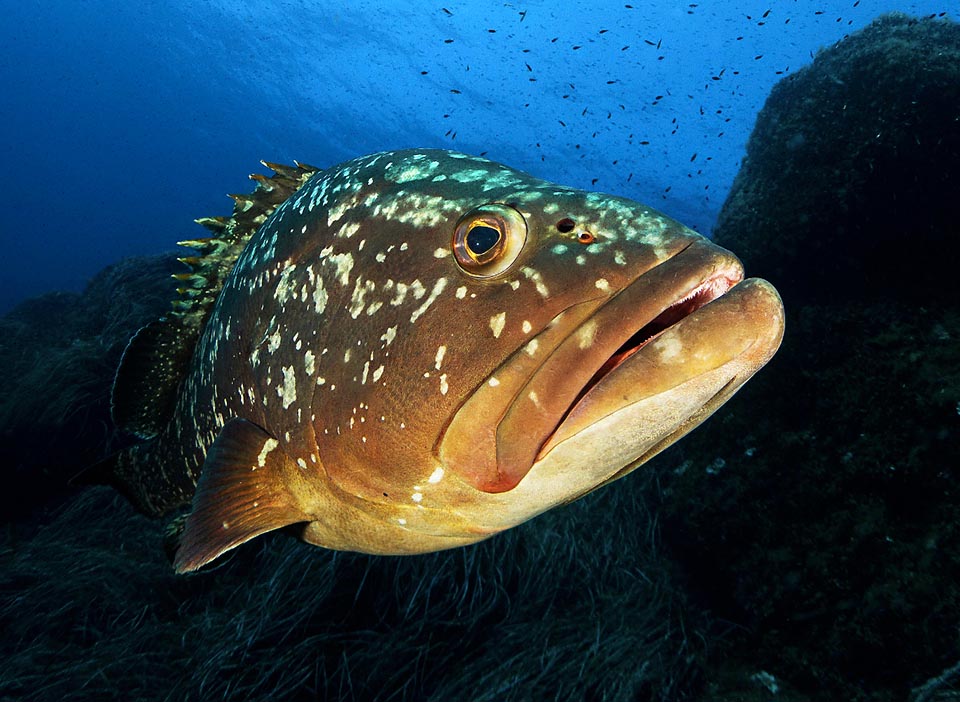
Increasingly rare in Mediterranean, the Grouper (Epinephelus marginatus) appears nowadays as “Vulnerable” in the list of the endangered species of the IUCN Red List © Gianluca Cucco
The Dusky grouper (Epinephelus marginatus Lowe, 1834) belongs to the class of Actinopterygii, the ray-finned fishes, to the order of Perciformes and to the family of Serranidae.
The genus Epinephelus originates from the Greek “epinefes'”, cloudy, with possible reference to the mimetic drawings, often changing, characterizing the livery of these fishes, whilst the term marginatus, having a margin, in Latin, refers to the fins with their clear border.
Zoogeography
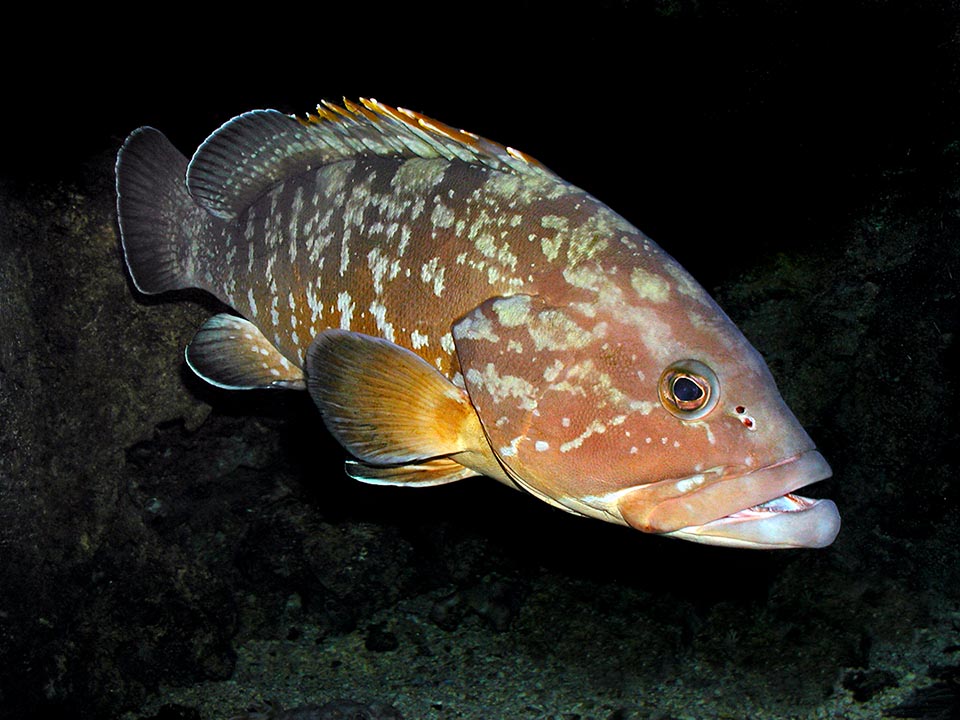
Present also in the Atlantic Ocean in Brazil, Uruguay and Argentina, and on the other coast from England to South Africa, then goes up in the Pacific up to Oman Gulf © Giuseppe Mazza
Once this species was very common in the Mediterranean, but by dint of going to the pot, due to the facility of catching and the prized flesh, it has almost disappeared in many zones, so much that in some nations, like in France, they have laid moratoria to the industrial fishing and the Principality of Monaco even forbids its sport fishing with the “Ordonnance Souveraine N° 107779” dated January 29th, 1993.
It is absent in the Black Sea, but, on the other hand, beyond the Gibraltar Strait, we find it along the Atlantic coasts: northwards, up to England and southwards up to, and beyond, the Cape of Good Hope. From here, it goes along the Indian Ocean African coast and it is reported in the waters of Madagascar, in the Gulf of Oman and at Reunion Island.
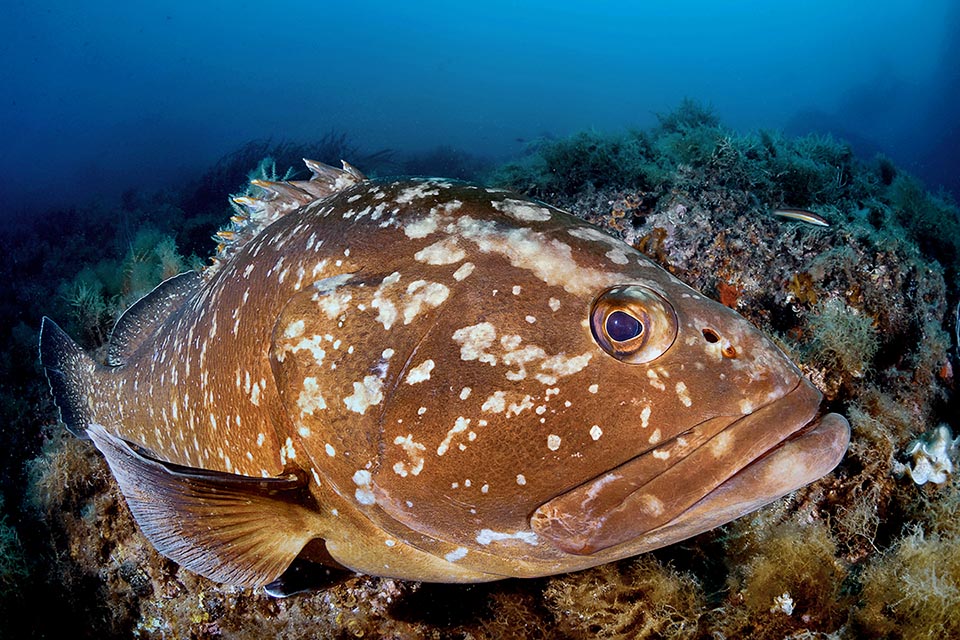
Can weigh 90 kg with a length of 150 cm, mainly nourishing of cuttlefishes, octopuses, squids and crabs, but also of fishes, in an increasing way depending on the size © Marcello Di Francesco
On the other side of the Atlantic Ocean, it is present in Brazil, Uruguay and Argentina.
Ecology-Habitat
It lives on the rocky seabeds, usually in the first sixty metres of depth, depending on the size and the seasons, but it seems that the old specimens may go down up to 300 m.
Recent studies done in France have confirmed, by means of transmitters placed on six specimens, that the Epinephelus marginatus is and extremely sedentary animal.
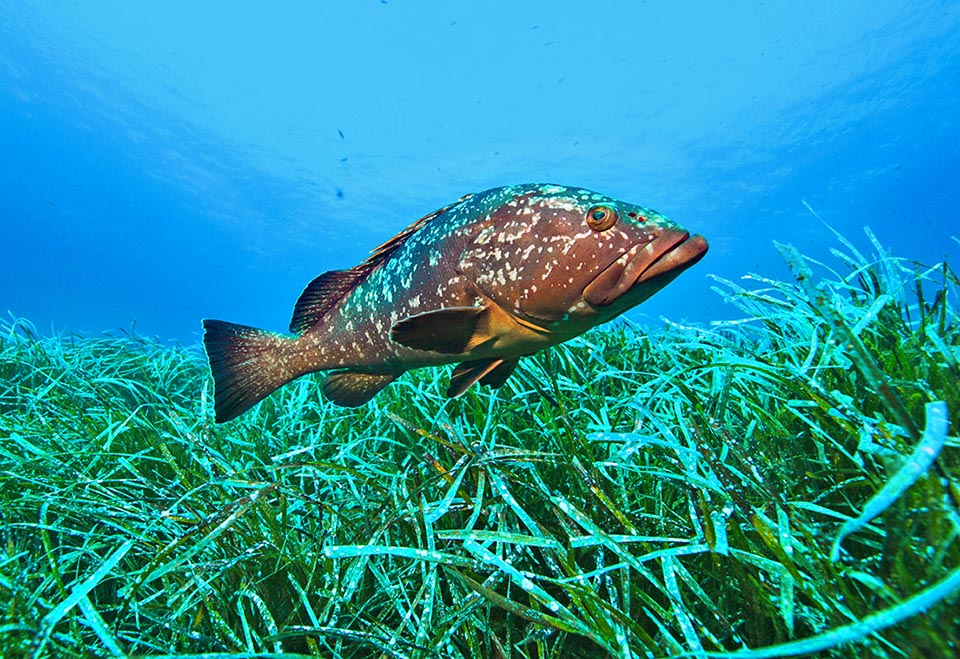
Frequents varied environments, like the posidonias prairies, but is extremely sedentary. When it finds a safe den, with a good hunting territory, it keeps it for years © Sandrine Ruitton
When it has found a safe den among the rocks, with a good hunting territory around, it will keep it for years.
Therefore, taken into account that it has a lifespan of 50 years, it is very sensitive to the changes made ny the man along the coasts.
Morpho-physiology
It can reach the 150 cm and a weight of 90 kg, but usually, nowadays, we meet much smaller specimens due to the industrial and sport fishing.
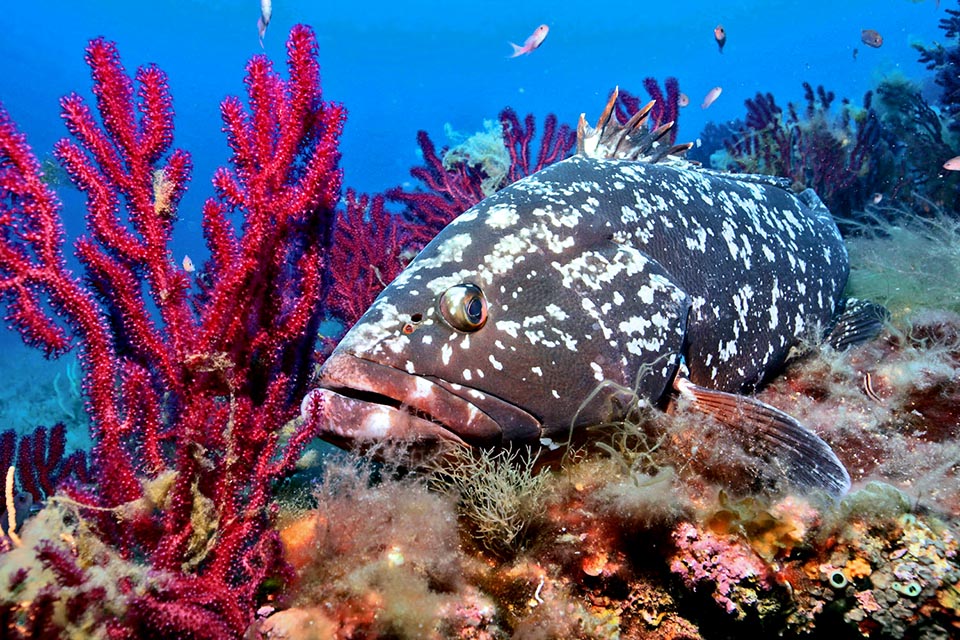
It is a solitary protogynous hermaphrodite species moving usually within the first 60 m of depth, even if old individuals can go down up to about 300 m © Sandrine Ruitton
But we have to think that a recent symposium held in Monte Carlo has concluded that a live dusky grouper, which enriches the seabeds with its presence by attracting the diving tourists, is much more profitable than a grouper in the dish.
The body of the Epinephelus marginatus, imposing, almost ovoid, with a big head and a huge, often open, mouth, has indeed all the necessary requirements for fantastic souvenir photos, so much that, in the reserves, often allows to be approached.
On both jaws we see, on the front, 4 caniniform teeth, followed by others, smaller, hooked, and the interior of the mouth is covered by rows of minor teeth.
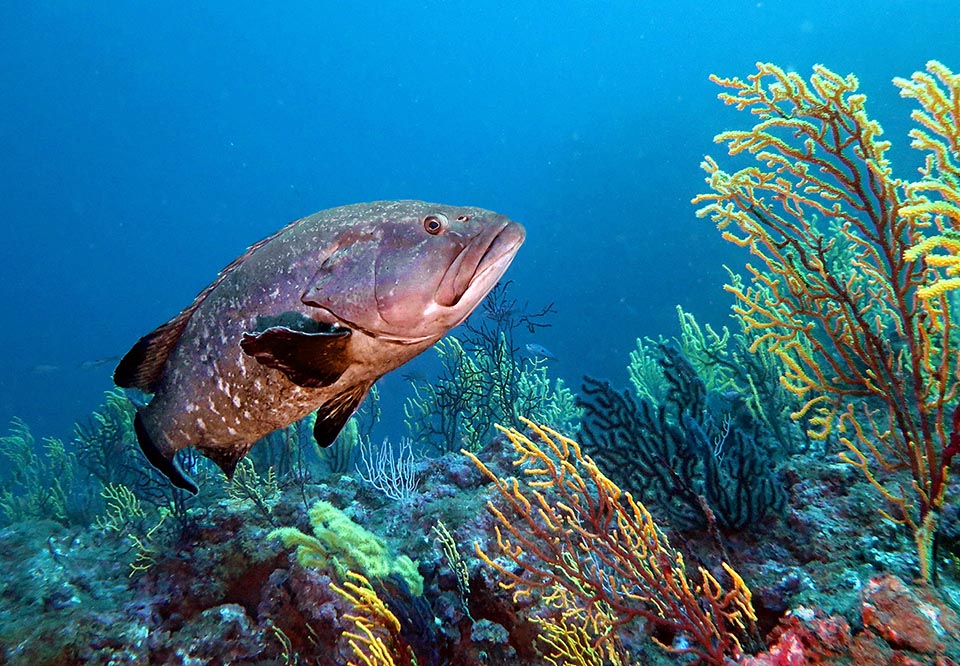
For the reproduction small aggregations take form with one or two males and some females. The eggs, fecundated in open sea, are entrusted to currents © Maxime Poulain
The only one dorsal fin had the first part formed by spiny rays, in this case 11, whilst the anal, smaller, has only 3 of them. The pectoral and ventral fins have no spines, are rounded as a spatula, and, unlike the other groupers, the tail remains roundish also in the adults.
The background colouration is brown-chocolate on the back and yellow-orange on the belly, with clearer dots and patterns, at times almost greenish, which may form mimetic vertical bands, visible only when the animal is alive and which disappear at the air a few hours after the demise.
Ethology-Reproductive Biology
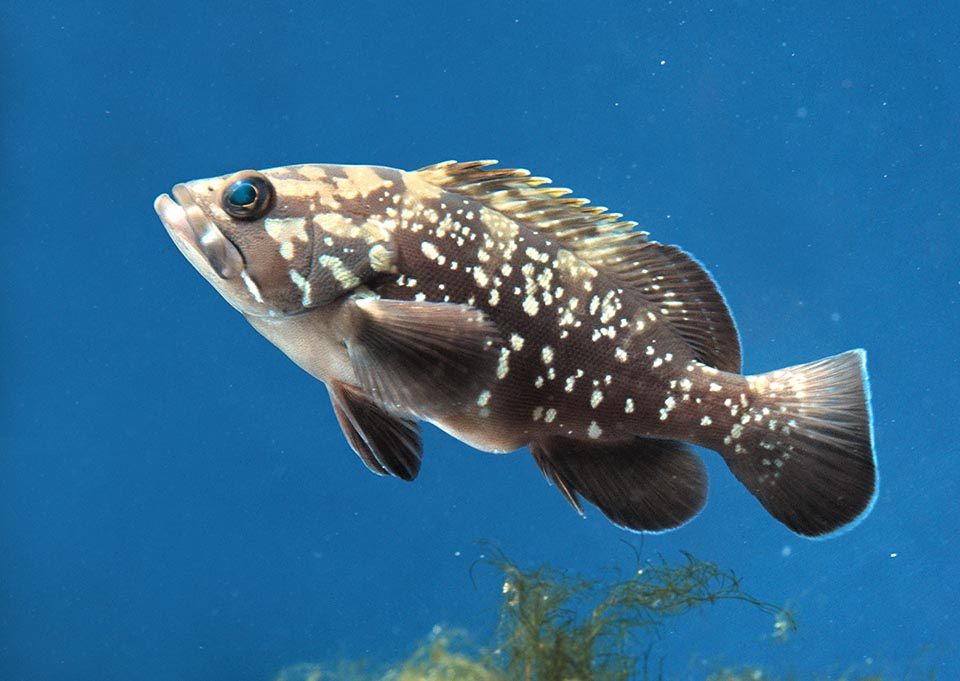
A juvenile. Epinephelus marginatus may reach the age of 50 years but the transformation of the old females in males is not automatic, as it was once thought © Giuseppe Mazza
Epinephelus marginatus eats mainly cephalopodic mollusks and crabs, without neglecting the fishes, with an increasing percentage according to the size.
It lives solitary. For the reproduction, small aggregations take form with one or two males and some females. The eggs, fecundated in the open sea, are entrusted to the currents.
It is a protogynous hermaphroditic species, but the transformation of the old females into males is not automatic, as it was thought once.
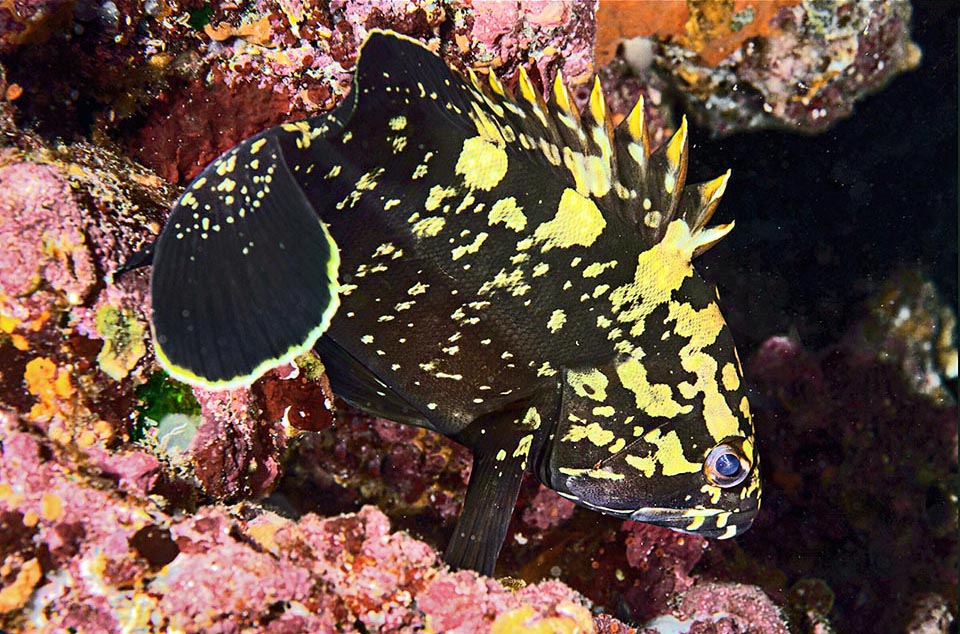
Another juvenile in defensive position who has accentuated its mimetic livery and shows the dorsal spiny rays. Actually the Grouper doesn’t have many enemies, but man © Ignazio Riccioli
The Monte Carlo symposium has revealed, in fact, that this change depends on environmental factors, on the age, and, especially, on the composition and the social life of the school. In fact, at the time of the reproduction it may be observed:
- isolated pairs of young individuals at their first love experiences
- small reproductive groups formed by one male with at least two females
- more ore less numerous aggregations formed by at least two males and many females. And it is in this case, when the females are in excess or when a male accidentally passes away, that the older “ladies” change sex in the interest of the species.
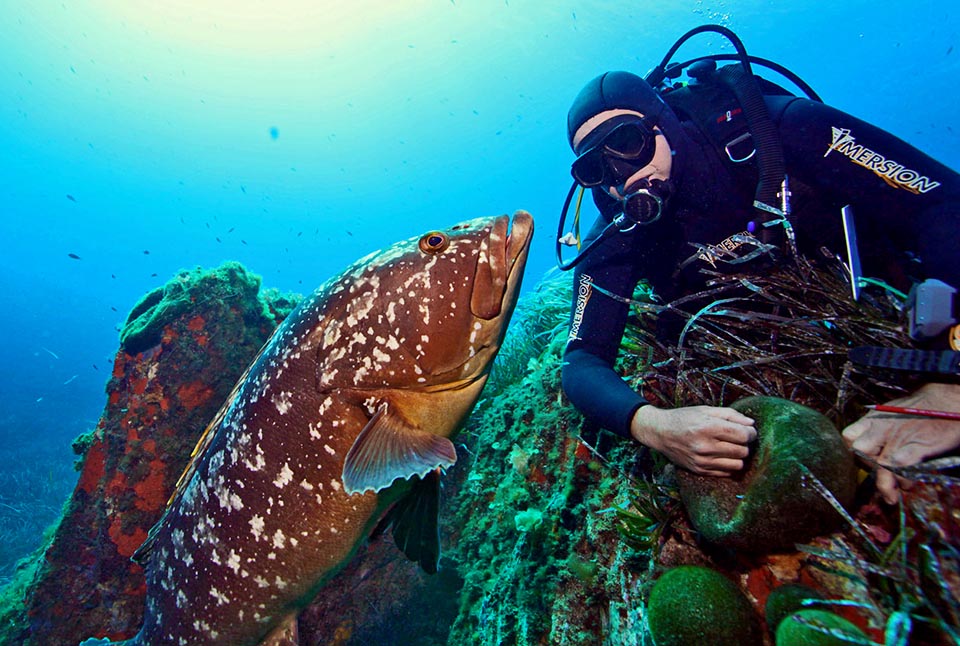
Two confronting worlds. Fished for meat or for sport, the Grouper is friendly towards the divers, losing its life in exchange or its den due to coastal works © Sandrine Ruitton
The populations of Epinephelus marginatus are on the decline everywhere, because of the very low resilience, with a minimum doubling time of the populations of 4,5-14 years, and a definitely disturbing fishing vulnerability index already marking 64 on a scale of 100. Since 2016 it has therefore been included as “Vulnerable” in the IUNC Red List of endangered species.
Synonyms
Epinephelus brachysoma Cope, 1871; Epinephelus gigas Brünnich, 1768; Holocentrus gigas Brünnich, 1768; Serranus aspersus Jenyns, 1840; Serranus cernioides De Brito Capello, 1867; Serranus fimbriatus Lowe, 1838; Serranus gigas Brünnich, 1768; Serranus marginatus Lowe, 1834.
→ For general information about FISH please click here.
→ For general information about BONY FISH please click here
→ For general information about CARTILAGINOUS FISH please click here.
→ To appreciate the BIODIVERSITY of BONY FISH please click here.
→ To appreciate the BIODIVERSITY of CARTILAGINOUS FISH please click here.
